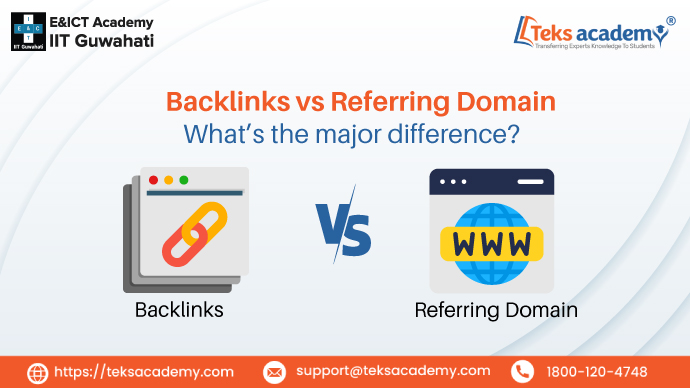What’s the major difference?
Hello digital marketing enthusiasts! As a beginner or even an expert in this digital field, sometimes you may have doubts regarding simple terms. From them backlinks and referring domains are mostly listened concepts. We know these are very useful in bringing organic traffic to your website. Also crucial for the SEO. It means they will play a vital role in making your site visibility.
But now the actual question comes – Do you truly know the difference between them? With the best digital marketing training you will gain all these insights in a practical way. This blog will help students, digital marketing learners and other enthusiasts. Here you will get to know the definitions of backlinks and referring domains and their major difference.
What is meant by Backlink?

Backlink is defined as “The link that connects one website to another site”. These can also be called inbound links. These are represented as a vote of confidence. Because it signals the search engines that your content is valuable and trustworthy. Your website needs to have high-quality backlinks. So, then there are more chances of ranking your website higher in search engine result pages (SERPs). Also, they should be from authoritative sources, so that it will improve your online visibility.
There are many types of backlinks like:
-> Editorial Backlinks
-> Guest Post links
-> Dofollow Backlinks
-> Nofollow links
-> Business Profile links
Example: Let us say you have the best software training institute and published a blog about “Top SEO trends for 2025”. In this case, a top tech blogger or leading IT company reads your blog and decides to share it on their own website.
They will include a link to your blog, this will act as a backlink. As a result, students looking for the best software training are likely to find and trust your institute.
What is a Referring Domain?
The definition of referring domain is “A website that has one or more number of backlinks”. These links will be pointing to another website. Represented as a unique source from which backlinks are originated. Even if multiple links come from the same website, it is considered as a single referring domain.
Example: As the best digital marketing training institute in Hyderabad, you have published a blog on “10 effective ways to improve your content strategy”. Several industry websites and education portals may find your
content valuable and link the blog to their platforms. Each of these websites are called as “referring domain”. Because they are sending traffic to your site through backlinks.
Main Difference Between Backlinks and Referring Domain:
Even though they both are valuable assets there is a slight difference between backlinks and referring domain. Understanding the key difference helps you in preparing better strategies:
| Factors | Backlinks | Referring Domain |
| Nature | These are the individual links received from other sites. | Referring domains are unique sources that generate backlinks. |
| Function | They transfer authority and traffic to a website. | Referring domains act as the sources that generate backlinks. |
| SEO Impacts | A high number of backlinks from the same domain may reduce your SEO value. | More unique referring domains signal higher trust and authority to search engines. |
| Quality Factor | Multiple links from a single domain may be seen as spammy if not diverse. | More diverse referring domains provide better link equity and organic ranking benefits. |
| Search Engine Trust | If they are spammy or low-quality, they can effect rankings. | A higher number of unique, authoritative referring domains helps build search engine trust. |
| Value & Best Practice | Focus on earning high-quality backlinks from authoritative sources rather than large quantities. | Prioritize increasing the number of high-authority referring domains rather than getting multiple links from the same site. |
How will these impact your SEO?
Till now we got to know about the backlinks and referring domains. Now let us know how these will impact in improving your SEO:
Increase Domain Authority (DA):
-> Search engines like Google will indicated these as “votes of confidence”.
-> More high-quality links from authoritative sites improve Domain Authority (DA), leading to better rankings.
Improve Search Engine Rankings:
-> Websites with more links from diverse sources rank higher on search engines.
-> Google’s algorithm sees these as an indicator of valuable content.
Boost Organic Traffic:
-> More links mean more referral traffic from other websites.
-> Users clicking on these links bring organic visitors, reducing the dependence on paid ads.
Faster Indexing by Search Engines:
-> Search engines will discover new pages faster.
-> This helps in quicker indexing of new content.
Build Website Credibility and Trust:
-> Backlinks from trusted sources improve your website’s reputation.
-> More referring domains show search engines that your content is valuable.
Always focus on quality over quantity so that getting links from relevant, high-authority sites is far more beneficial than low-quality backlinks.
Conclusion:
I hope you got a clear understanding of the difference between backlinks and referring domains and how they impact your SEO. While backlinks act as trust signals, referring domains will be the credibility of those signals. This knowledge will be a game-changer for your search engine optimization. Always focus on quality rather than quantity for your long-term success in digital marketing.







One Response
It’s interesting to see how backlinks are sometimes confused with referring domains, but they actually serve slightly different roles in SEO. While backlinks are specific links pointing to your site, referring domains tell search engines how many unique sources are linking to you. Both are critical for boosting online visibility!